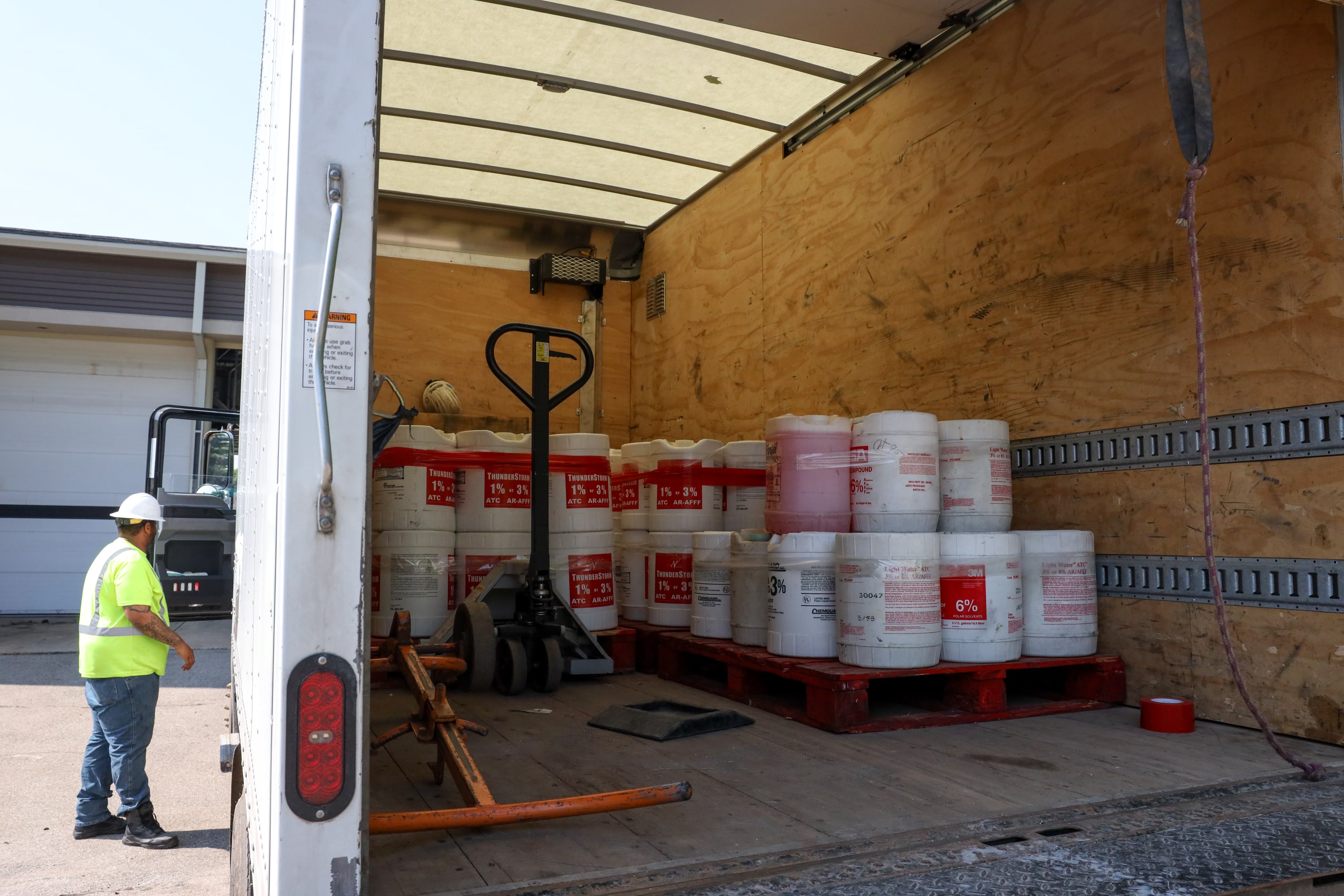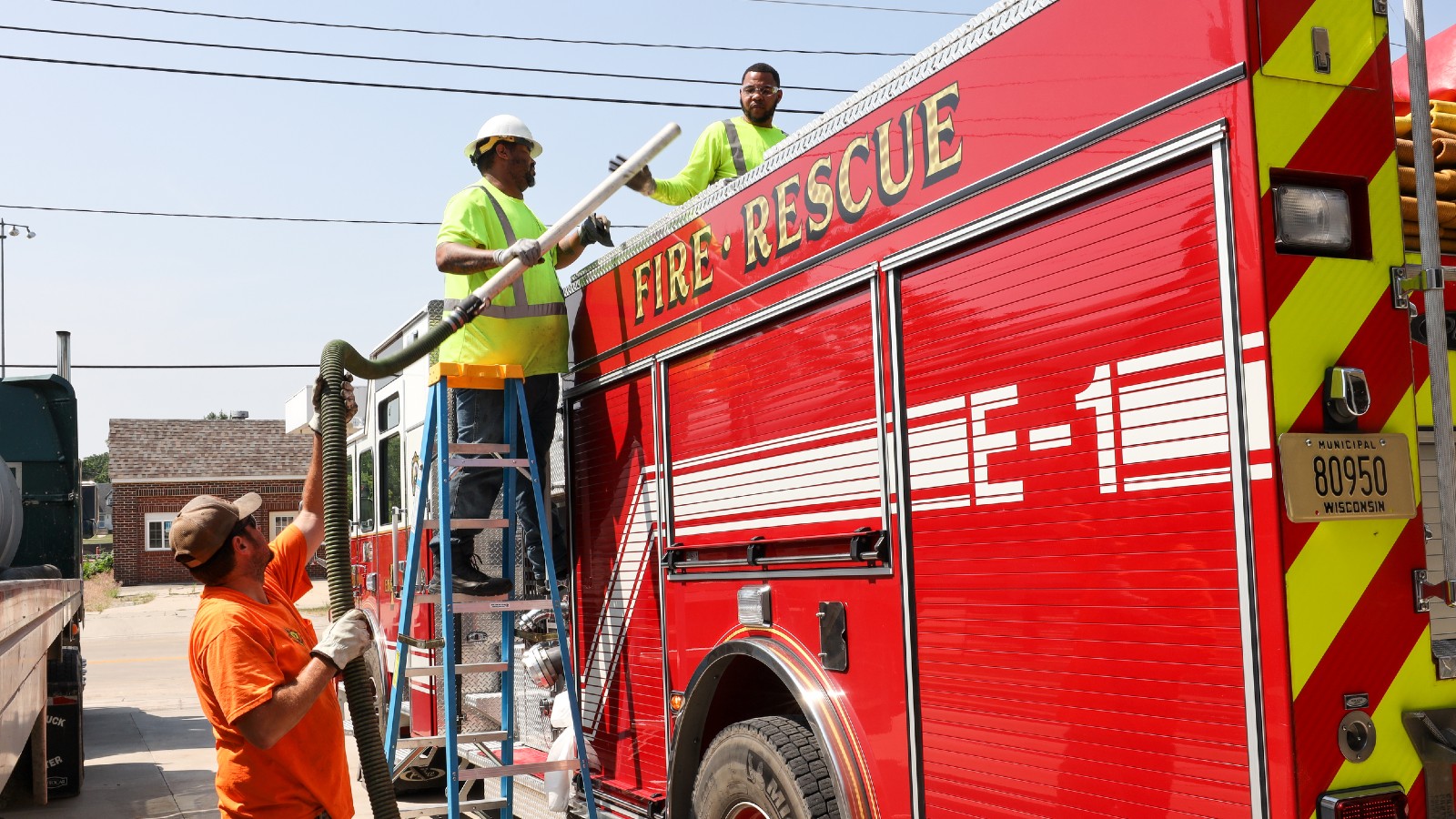This article first appeared on Wisconsin Watch and is republished here under a Creative Commons license.
Five-gallon plastic pails holding a toxic chemical linked to cancer sat for years on the shelves of a fire department in south-central Wisconsin. Finally, in a heralded statewide cleanup, they were gathered up and shipped off.
“I don’t have to worry about something being knocked over, broken open,” said Jefferson Fire Chief Ron Wegner. “So it’s just nice to have it gone.”
But where did it go?
It turns out there are no easy answers for dealing with “forever chemicals” called PFAS: a family of 12,000 human-made compounds that don’t readily break down in nature. Removed from Wisconsin, the birthplace of the modern environmental movement, means buried in the ground in Alabama, where the federal government has flagged areas as vulnerable to environmental injustice.
In Wisconsin, experts weighed the most socially and environmentally responsible solutions. The state is trucking more than 38,500 gallons of PFAS-containing firefighting foam more than 700 miles to Emelle, Alabama, the home of one of the country’s largest hazardous waste landfills.
It sits in the Alabama Black Belt, a string of rural counties historically known for fertile and dark soil, America’s Cotton Kingdom and the slave trade. Remnants of that legacy still show today. Sumter County is home to 12,345 residents, about 70 percent of whom are Black and nearly a third of whom live in poverty. More than half are unemployed.

“A state that is predominantly white is sending its waste that’s toxic to the Black Belt,” said sociologist Robert Bullard, a Texas Southern University professor who surveyed Emelle residents in the 1980s as part of a landmark study on environmental racism in the American South. “It’s not going to a predominantly white area in Alabama. It’s not going into the rich area. It’s going to the Black Belt.”
In 1977, relatives of segregationist Alabama Gov. George Wallace opened the landfill, which Chemical Waste Management purchased the following year. It sparked opposition from its birth, with detractors believing developers targeted a community that lacked the power to object. Today, Chemical Waste Management annually disposes of 274 million pounds of hazardous waste from all over the nation.
The landfill’s entrance sits a few hundred yards from M&M Market, a gas station and lunch counter where two old high school friends chatted on a summer afternoon.
A woman served the day’s lunch special, country-fried steak. The two companions reminisced about graduating from Sumter County High in 1973. Talk turned to rumors about the next batch of waste destined for the landfill.
“You can’t safely contain nothing that’s man-made,” said military veteran Jimmie Williams, 69. “So why bring it in here?”
He sees a lot of sickness around him — conditions people don’t understand, like heart disease, strokes and even unexplained death in young people. There is no evidence to suggest it is connected to PFAS or the landfill, but he feels in the dark.
“We don’t know,” Williams said. “We’re lost.”
PFAS cleanups left to states
As public alarm about PFAS grows, many states are grappling with the chemicals, which are found in a bevy of consumer products like nonstick pans, food wrappers and raincoats.
Firefighters question how to handle stockpiles of fluorinated foam that contains PFAS. The U.S. Environmental Protection Agency has yet to institute disposal requirements, leaving states to “figure out what to do,” observed Darsi Foss, a former Wisconsin Department of Natural Resources division administrator who led the team that developed the foam collection program.
Officials in some states opted to burn the foam, which can disperse PFAS into the air.

Without an affordable and safe way to destroy the compounds, a hazardous waste landfill seemed best.
But Bullard, often called the “father of environmental justice,” said transporting PFAS to Emelle perpetuates — even if unintentionally — environmental racism by disproportionately shifting the burden and risk onto a largely poor community of color. While Wisconsin can discard a piece of its PFAS problem, Sumter County residents lacked the choice of whether to accept it.
Emelle fits into a larger pattern, Bullard said. A 2007 study he led found people of color made up 56 percent of the population in neighborhoods near the nation’s hazardous waste landfills. The figure jumped to 69 percent when analyzing clusters of two or more facilities. Race independently predicted hazardous waste locations— more than income and education levels.
There has been no reported contamination of community drinking water due to the Emelle landfill, and company spokesperson Tricia Farace told reporters the facility “utilizes engineered controls to prevent impacts to groundwater and the neighboring environment.”
But Bullard says medical outcomes alone can’t measure effects.
Few people, he said, want their community to be considered America’s “waste dumping ground.”
“Harm can be measured in terms of the extent to which people are disrespected.”
Wisconsin touts firefighting foam collection
Manufacturers comprehended the hazards of PFAS by the 1960s but concealed them for decades.
Thousands of U.S. cities and counties, and a host of states and utilities, including many in Wisconsin and Alabama, sued the 3M Company, DuPont and other manufacturers, alleging they failed to alert the public of exposure risks, such as altered hormone levels, high cholesterol, hypertension in pregnancy, kidney and testicular cancers and reduced vaccine effectiveness. In 2022, the EPA released health advisories, suggesting virtually no amount of several PFAS is safe for consumption.
The chemicals are increasingly turning up in public drinking water around the country, prompting cleanup efforts nationwide.
In a 2020 survey of Wisconsin fire departments, about 76 percent of respondents said they possessed or previously used fluorinated foam, some dating to the 1980s. Many wanted to learn about their liability and how to get rid of the stuff.
One department explained that nobody would take its stored foam, while another reported awaiting government assistance, according to redacted survey responses provided to reporters through a public records request. Two departments previously sent their foam to an incinerator, and one dumped it into the sewer.
In 2021, Wisconsin lawmakers allocated $1 million to collect the foam.
“We’ll be gathering that PFAS and finding the right and appropriate way to get rid of it and get it off the landscape,” extolled former Wisconsin Department of Natural Resources Secretary Preston Cole, the state’s top environmental official, last year. “What we’re doing at the DNR is rolling up our sleeves, and on the heels of the 50th anniversary of the Clean Water Act.”
Officials examined other state approaches.
At least two, Massachusetts and Rhode Island, opted to incinerate their fluorinated foam. Washington considered doing so, but withdrew the proposal in the face of public concern over pollution risks. Colorado paid fire departments to store their foam. New York officials would not disclose their disposal methods to reporters. Michigan and Indiana contracted with a company that owns a hazardous waste landfill in Idaho.
Wisconsin took its cues from its Midwestern neighbors.
“We really felt like, at that time, using the hazardous waste landfill was the safest option available,” said Mimi Johnson, director of the Office of Emerging Contaminants at the Wisconsin Department of Natural Resources. “There are not many in the country, and in particular, that will take PFAS, knowingly.”
None of the country’s 60 permitted hazardous waste landfills are in Wisconsin.
The state contracted with North Shore Environmental Construction, which it previously hired to clean up PFAS spills.
Dave Johnson, the company’s executive vice president, said North Shore has long worked with Chemical Waste Management.
Chemical Waste Management also offered indemnification to Wisconsin for liability in case the landfill is ever flagged for cleanup under the federal Superfund law.
“We give recommendations on where it goes,” Johnson said. “The customer has to decide: What is their company’s risk? What is their company’s image? … What’s cost-effective now? What’s socially responsible?”
When North Shore contracted with the state, the company committed to avoid contributing to environmental injustice.
“You obviously don’t want to go into an area that’s going to be a disadvantage to somebody,” Johnson said.
When asked, Mimi Johnson said the Wisconsin Department of Natural Resources was unaware of the Alabama landfill’s contentious history.
In November 2022, the agency hired an environmental justice policy adviser, Julie Majerus, who was not involved in the planning of the PFAS collection program.
“The DNR cannot change the fact that the disproportionate harms currently exist,” she said, “but we can begin the work to right those harms and better engage with the communities most impacted to include their voices in our decision-making.”
Landfill ignited Alabama protests
Multiple protesters chained themselves to a fence in protest of Emelle becoming what they called the nation’s “pay toilet.” It was November 1987, and they aimed to block waste trucks from entering the landfill.
Traces of toxic chemicals had been found in the soil at the site, according to local news reports. The state said it would test further.
One chained activist was a local housewife and a former Baptist Sunday school teacher. Another was a civil rights leader who had marched with Martin Luther King Jr. across the Edmund Pettus Bridge in Selma, Alabama, in 1965.
They were arrested and charged with criminal trespassing.
From the landfill’s founding, the site generated numerous demonstrations and spurred the formation of grassroots organizations like Sumter Countians Organized for the Protection of the Environment and Alabamians for a Clean Environment, or ACE. However, Chemical Waste Management also was one of the region’s largest employers, and its payments through a state-imposed waste tax provided crucial revenue for schools and county government, increasing the difficulty of opposing the facility.
Linda Munoz, an early ACE leader, initially had no idea a hazardous waste landfill had been built in Emelle, about 23 miles away from her antebellum home in the woods of Cuba, Alabama. It was an era when the country was still trying to figure out what to do with its hazardous and toxic waste, prior to federal regulations.
“And I thought, ‘No way. That’s just not possible.’ So I started doing some research,” she told reporters this summer. “There was nothing that had to be done about the waste or the way it was dumped or the linings or anything.”
Munoz worried that toxic materials might leak into the aquifer beneath the landfill.
“Are they giving us blood money for this?” she asked. “We have one of the poorest counties in Alabama and probably in the United States. So it just isn’t fair for us to be the sacrifice zone.”
‘You have to beg for what you want’
On a June afternoon, Dorothy Oliver stepped into the small mobile home she runs as a convenience store — selling chips, toilet paper, soap, cigarettes and basic essentials in Panola, a town of 74 about 15 miles north of Emelle.
Oliver jokes that she is Panola’s informal mayor, and her trailer store is like a city hall. People seek her help when trees fall. She and a county commissioner work to get the area roads fixed. Oliver helped bring vaccines to Panola during the COVID-19 pandemic, and she’s trying to build a tornado shelter.
“We’re in a rural, Black area in Sumter County,” she said. “You have to beg for what you want, and that’s sad.”
Oliver worked in Chemical Waste Management’s records department for three decades, and she thinks the company was well run — and that it properly handles waste.
But how does she feel about Wisconsin’s PFAS?
“I don’t think it’s fair for you to take your waste and ship it to an almost all-Black county,” Oliver said.
Sumter County accepted it, she said, but she can’t imagine the reverse.
“Wisconsin would have said, because they’re majority white, they would have said, ‘We ain’t going to have it.’”
Landfill handles most toxic waste
The Emelle landfill’s approximately 130 employees pass by farms, pastures and woodlands on their way to work. Turning off the two-lane State Highway 17, they reach a 2,630-acre campus surrounded by a chain link fence. Signs warn, “Danger, Unauthorized Persons Keep Out.”
One active landfill trench at the site is large enough to hold 1 ½ times as much waste as could fit inside the Great Pyramid of Giza. Nearly two dozen more trenches are filled and closed. The oldest underlie the employee parking lot and several buildings. Others are capped and covered in grasses and crimson clover.
The facility receives “virtually every type” of hazardous and toxic waste regulated by federal and state officials: asbestos, cyanides and polychlorinated biphenyls, or PCBs, to name just a few. All of it arrives by truck, usually semitrailers — about 50 a day. Drivers sign in at a guard house, then pass through the main gate before laboratory staff verify the contents of waste and determine how to manage it.
Some containers are stored in corrugated metal buildings before they are transferred, treated or buried. Hundreds of plastic and steel drums fill the interior aisles, sometimes stacked two high, atop concrete and stainless steel floors.
Mike Davis, the landfill’s senior district manager, said the facility expects more PFAS to come.
“Because it’s an issue of public concern,” Davis said. “A lot of people don’t know what to do because there hasn’t been any direction given yet. So the best thing to do is send it to a facility like ours, and we manage it correctly.”
Region boomed when cotton was king
Emelle Mayor Roy Willingham Sr., 80, stepped out of a white pickup truck and walked into city hall.
Construction of the tan, concrete building was paid for by Chemical Waste Management. But there isn’t much else to Emelle: a grassy park with an old basketball court, shouldered by a post office, an abandoned antique shop and a shuttered country store. A once-paved road, mostly eroded to gravel, encircles the park. The derelict gas station on the nearby highway sports vintage pumps.
Emelle’s population of mostly older residents live in trailers or one-story, brick mid-century homes. But Willingham remembers, many decades ago, when a cotton boom brought crowds.
“There was a train running all the way to Mobile,” he said. “There were so many people out. It was amazing.”
Willingham said his grandparents were emancipated from enslavement in Mississippi and his father moved to Alabama to open a blacksmith shop. His mother was a schoolteacher.
Willingham joined the Great Migration, moved to Detroit and served in the military. He went to college under the G.I. Bill and eventually moved back to Emelle to be with his elderly mother. He worked at a Walmart in Tuscaloosa, and later at the Department of Mental Health.
“I played around with several different jobs and I ended up being mayor of the town,” he said.
On a July night, Willingham joined a meeting concerning the town’s failing sewage system.
“Come back and get a drink of water!” he told a pair of reporters.
Willingham said Chemical Waste Management brings money and jobs to Emelle. He doesn’t worry about the landfill because the town lacks the information to scrutinize health effects.
Willingham said profit and wealth have shaped life in Emelle ever since the American slave trade.
“What was done to create a labor force through slavery is done to bury chemicals in a poor neighborhood,” he said. “That’s just finances. It was about money.”
Landfills store PFAS but don’t destroy them
Wisconsin might save money by ditching its foam now.
Department of Natural Resources administrators believe the EPA will eventually classify PFAS as hazardous waste and implement national PFAS drinking water standards, driving up disposal costs. Prices could climb after the Federal Aviation Administration lifts mandates that airports use fluorinated foam, as more of it will need a resting place.
Chemical Waste Management’s parent company, Houston, Texas-based Waste Management Inc., recently told investors that new PFAS standards can be viewed as “potential business opportunities.” With revenues of $19.7 billion in 2022, the company owns or operates North America’s largest network of landfills, including five storing hazardous waste.
Depositing fluorinated foam in a hazardous waste landfill is “a step in the right direction” because the waste will be treated and monitored, said professor Rainer Lohmann, who directs the University of Rhode Island’s STEEP lab, which researches PFAS’ effects on health and the environment.
But landfills would better be viewed as a PFAS “storage facility” than a means of disposal, he said. The properties that make the chemicals so useful, like heat resistance, also make them difficult to destroy.
Modern hazardous waste landfills are designed to last for centuries, with double liners, leak detectors and collection and treatment systems for leaching waste.
Yet the EPA acknowledges that all landfills represent a potential contamination source after closure. “Even the best landfills at this stage,” Lohmann said, “they will start failing.”
Chemical Waste Management says landfill protections robust
Chemical Waste Management calls the 600 feet of “Selma Chalk” limestone atop which the Emelle landfill sits virtually “impermeable,” allowing water to penetrate at a rate of approximately 1.2 inches per year. If there were any problems at the facility, the company argues, it would take millennia for spills to reach the aquifers below. Additional safeguards should prevent any chemicals from leaving the trenches.
Several use special liners that collect leachate, fluids generated when liquids percolate through waste contained in a landfill. The leachate is pumped to a colossal cluster of tanks for treatment, after which it is mixed with a substance like kiln dust or fly ash that forms concrete when water is added. The resulting material is buried on site.
Most landfills send their leachate to wastewater treatment plants for treatment and release into the environment. But those facilities aren’t designed to remove or destroy PFAS, so the chemicals reenter the environment. Davis, the manager, said releases like that can’t happen at Emelle since no liquids are discharged.
Emelle’s operators tout the landfill’s robust system of protections, but it’s not perfect.
Twenty of the landfill’s trenches, many dating to the late 1970s, use no base liner other than compacted chalk or clay. Several leak.
As early as the 1980s, monitoring wells detected toxic chemicals within the vicinity of the facility’s first six trenches, which stored 160 Olympic swimming pools’ worth of corrosive waste, toxic metals, ignitable materials, herbicides and pesticides, wastewater sludge and PCBs.
As the trenches were excavated, workers installed a chalk cutoff wall to minimize the movement of hazardous contaminants through groundwater, but continued monitoring also has detected the toxic chemicals in the soil and groundwater outside the wall’s perimeter.
Chemical Waste Management attributes their presence to mishandling and spills during waste disposal, not trench leaks, and insists the chalk wall has effectively halted leaching.
Meanwhile, recent inspections by the Alabama Department of Environmental Management have documented multiple violations.
More than two dozen containers of hazardous waste were found rusting or damaged, and 16 more were leaking, according to an April report. Inspectors observed an uncleaned spill, approximately two years old, from a leachate storage tank. A concrete floor on which mercury containers were stored was cracked, the report added.
Landfill management disputed many of the regulators’ findings — no containers were damaged or leaking, they said, and spots inspectors thought were spills were actually stain residue. Other violations were corrected.
State and federal inspectors also found during a recent visit that the company failed to maintain records of PCB waste and properly label containers. Inspectors struggled to identify items, which had been “randomly stored,” intermingled with other types of hazardous and non-hazardous materials.
Landfill hearing draws sparse crowd
Recently, Chemical Waste Management’s 10-year operating permit went up for renewal.
Before the start of a state-required public hearing held in Livingston, Alabama, in April, local and state officials, along with company representatives, stood by booths awaiting questions from residents. Few appeared.
As the hearing began, Sumter County Commission Chairman Marcus Campbell stepped up to a lectern and sang the landfill’s praises.
“We’re in an area where all is needed, and, again, we want to provide our citizens with the best,” Campbell said. “We look at the North Sumter Daycare, we look at our local hospital, Hill Hospital, we look at our Industrial Board, just a few of the entities, whereas Waste Management, with the waste tax, we’re talking about over a total, probably over 30-plus entities that are supported by Waste Management.”
Two residents, Terry Roswell and Pierce Boyd, spoke out against renewing the permit. Their families own property nearby and have fought against the landfill for decades.
“I think they picked this area because people were poorly informed, and many of them poorly educated,” said Roswell, later saying he worries about the safety of drinking water. “And it’s like you’re living with the sword of Damocles over your head all the time. If it ever goes bad, it goes.”
The landfill manager said anyone with concerns could tour the site. He invited reporters in attendance to visit. A spokesperson later told reporters that there were no tours and denied the request.
Waste Management did not respond to a list of emailed questions about landfill practices, but offered a statement that noted, “The health and safety of our communities is Waste Management’s top priority, and we are committed to playing an active role in the solution to the disposal of PFAS.”
America must reckon with its refuse
Wisconsin’s collection program will continue into the fall.
Dave Johnson of North Shore expressed confidence in Chemical Waste Management’s “state-of-the-art” safety controls and decades of experience. But one day, he said, America must reckon with its refuse.
“Really all we’re doing in this country is just putting our waste into centralized locations,” he said. “At some point, all these landfills are going to have to be dealt with.”
Johnson called Bullard’s remarks “very fair.”
“Unfortunately, we can only do what current regulations and disposal options are available to us and what provides the best protection long term for the waste and the state of Wisconsin,” he said.
Protests of Alabama’s role as the nation’s dumping ground have quieted since drawing national attention in the 1980s.
A historical marker in Emelle touts the town while acknowledging residents’ unsuccessful bid to shutter the facility. The landfill remains a fact of life.
M&M Market’s owner, Mary McClure Ozment, 40, operates the cash register while the two friends eat.
She isn’t worried about the landfill, and neither is anyone else she knows.
Ozment talks to people who work there who tell her it is safe, and she says that is enough for her.





